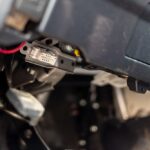It can be frustrating when you use your OBD2 scanner, hoping to clear a trouble code, only to find that it just won’t erase. Many car owners and even some technicians run into this situation. The key to understanding why this happens lies in recognizing the different types of Diagnostic Trouble Codes (DTCs) your vehicle might be throwing. Not all DTCs are created equal, and some are designed to be more persistent than others.
Understanding Permanent Diagnostic Trouble Codes (PDTCs)
Permanent Diagnostic Trouble Codes, or PDTCs, are specifically designed to remain even if you disconnect your car battery or use a standard OBD2 scanner to clear codes. According to the Bureau of Automotive Repair (BAR), PDTCs are set when a fault is detected that impacts emissions. The crucial thing to understand about PDTCs is that they are not erasable by simply using a scanner.
The only way to get rid of a PDTC is to address the underlying issue that initially triggered the code. Once you’ve repaired the problem, the vehicle needs to be driven through specific drive cycles. During these drive cycles, the car’s computer, or Powertrain Control Module (PCM), will re-run the diagnostic monitor related to the fault. If the monitor completes without detecting the problem again, the PDTC will clear itself automatically. Essentially, your car is verifying that the repair is effective before allowing the code to be removed.
Decoding Pending Diagnostic Trouble Codes
Pending codes, sometimes called “maturing codes,” are a step before a full DTC. These codes indicate that a potential issue has been detected, but it might be intermittent or needs confirmation. Pending codes appear when a fault occurs during a warm-up cycle. The PCM then waits to see if the fault reappears in a subsequent warm-up cycle.
If the fault doesn’t occur again within 40 warm-up cycles, the pending code will automatically disappear from the system’s memory. However, if the same fault is detected again within a certain number of warm-up cycles, the pending code will “mature” into a regular DTC. When this happens, it will trigger the check engine light to illuminate on your dashboard, alerting you to a persistent problem.
Navigating History Diagnostic Trouble Codes
History codes are records of past DTCs that were once active but are no longer currently triggering a fault. Think of them as a historical log of issues your vehicle has experienced. These codes can be helpful in diagnosing intermittent problems that come and go.
Clearing history codes can vary. Some OBD2 scanners can successfully erase history codes directly. However, other history codes might require a “double code clearing” process, which might involve specific steps with your scanner. Furthermore, certain history codes are designed to clear only after a set number of ignition cycles or drive cycles have been completed under specific conditions.
To effectively clear a history code that isn’t straightforward, it’s best to consult your vehicle’s service manual. The manual will provide specific instructions for each code, outlining the conditions required for it to be cleared. Following these guidelines while driving your vehicle is often necessary to erase these persistent history codes.
